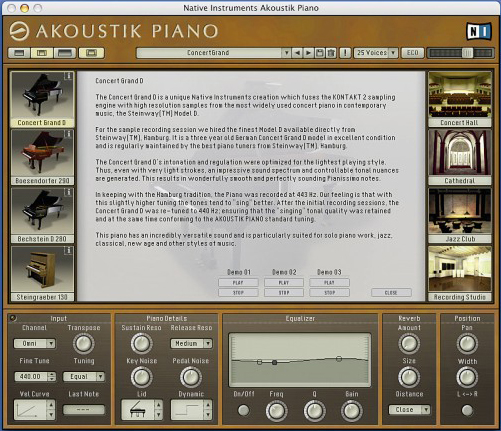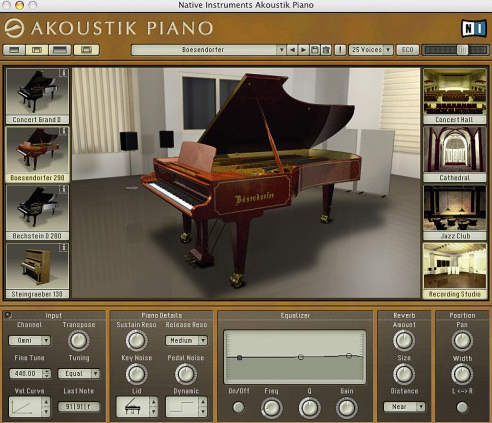MusicRadar Verdict
You can´t fail to be impressed by Akoustik Piano. It´s a piano-lover´s paradise.
Pros
- +
Superb feel and sound. Easy-to-use interface. Excellent convolution effects. Beautifully presented.
Cons
- -
For best results, you need a hammer action keyboard. Manual contains some anomalies.
MusicRadar's got your back



Akoustik Piano (what is it with that 'special K'?) contains four different models: a Bosendorfer 290 Imperial Grand; a Bechstein D 280 Grand; a Steingraeber und Soehne Vintage Upright 130; and the Concert Grand D (this last piano features samples from the Steinway Model D).
Those who are running short of hard drive space will be pleased to know that you don't have to install all of the pianos simultaneously (each one comes on a separate DVD) but if you do want to copy over the complete library, you'll need about 15GB of spare space on your disk.
The software will run standalone - this is useful if you just want to sit down and play - and as a VST, DX, AU or RTAS plug-in.
The interface
Akoustik Piano's interface has something of a 'classical' feel to it, and is far less techy and intimidating than some of NI's other GUI's. The company clearly see this as an instrument for musicians as well as producers, so they've tried to keep things as simple as possible.
The centre of the screen contains a picture of the currently selected piano model. All four are shown to the left and you can choose one by clicking its image.
To the right of the interface are four more images - these depict Akoustik Piano's built-in convolution effects. There are Concert Hall, Cathedral, Jazz Club and Recording Studio options, and each one is designed to recreate a different type of acoustic space.
Want all the hottest music and gear news, reviews, deals, features and more, direct to your inbox? Sign up here.
Some pianists will be content simply to load a piano model, choose a suitable convolution effect and play, but Akoustik Piano can be used on a deeper level if you want to tweak your sound further. A collapsible editing window plays host to all the main tone shaping parameters, though it should be said that there's nothing too complex in here either.
The Input section enables you to choose the MIDI channel, transpose the piano and adjust its tuning, and also select the velocity curve that's best suited to your MIDI keyboard. The character of your piano can be tweaked in the Details section, and next to this is a 3-band EQ.
The editor is completed by Reverb and Position sections; the former features Amount, Size and Distance controls, while the latter enables you to tweak the pan position and adjust the width of the stereo field.
Getting hands on
Akoustik Piano is certainly an elegantly designed piece of software, but the truth is that you probably won't spend a massive amount of time poring over its GUI. This is an instrument that begs to be played, and when you do play it, you can't fail to be impressed.
Each piano sounds noticeably different, but it's evident that they've all been painstakingly sampled and that a great deal of care has gone into retaining the sonic character of the originals. Whether you caress them gently or hit them hard, these instruments feel marvellous and sound truly magnificent.
The grands are as expansive and pristine as you'd expect them to be, but the upright model is also worth investigating. As NI point out, it has more of an 'imperfect' sound than the other three pianos, but this will suit certain productions. We're very pleased to see it included.
The convolution effects complement the pianos very well, enabling you to change the environment you're playing in at the click of a mouse.
We should also make special mention of the sustain resonance feature, which recreates the sound made by a piano's strings and body after the dampers have been lifted. This helps to add extra realism, especially when used in conjunction with a sustain pedal.
In summary
So is this the best set of sampled pianos on the market? It's nowhere near as big as Synthogy's Ivory, but we don't think it sounds noticeably worse.
One small gripe concerns the manual: this was clearly based on a pre-release version of Akoustik Piano, and the interface described within it is slightly different.
Nevertheless, Akoustik Piano is a top quality, outrageously easy to use piece of software. It's full of nice touches - you even get a 2-track recorder and a MIDI file player - and, at times, feels as much like a celebration of the instruments it emulates as it does a workhorse piano module.
With its powerful engine, stylish interface and exquisite samples, we'd say that NI's is the classiest piano solution around.
MusicRadar is the number one website for music-makers of all kinds, be they guitarists, drummers, keyboard players, DJs or producers...
- GEAR: We help musicians find the best gear with top-ranking gear round-ups and high-quality, authoritative reviews by a wide team of highly experienced experts.
- TIPS: We also provide tuition, from bite-sized tips to advanced work-outs and guidance from recognised musicians and stars.
- STARS: We talk to musicians and stars about their creative processes, and the nuts and bolts of their gear and technique. We give fans an insight into the craft of music-making that no other music website can.
